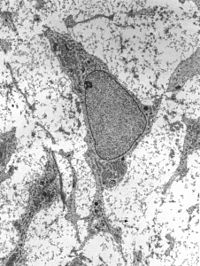
Photo from wikipedia
Simple Summary Cardiovascular diseases are worldwide one of the leading contributors of mortality, and among multiple therapeutic approaches, stem cell therapy has been introduced as a robust therapeutic strategy to… Click to show full abstract
Simple Summary Cardiovascular diseases are worldwide one of the leading contributors of mortality, and among multiple therapeutic approaches, stem cell therapy has been introduced as a robust therapeutic strategy to alleviate related symptoms and restore cardiac functions. Prior to this, however, for successful cell therapy, an adequate number of functional and safe cardiac cells needs to be generated. For this purpose, our approach was boosting the proliferative capacity of stem cell-derived cardiomyocytes using growth factors, such as fibroblast growth factor 10 (FGF10) and cardiotrophin-1 (CT-1). Our results demonstrated that FGF10 and CT-1 substantially increased the number of cardiac cells that originated from stem cells. In molecular assays, to assess RNA and protein level alterations, the enhanced presence of specific markers for cardiac cells after treatment of stem cells with FGF10 and/or CT-1 was confirmed. This inducing potential of cardiac cells can particularly be applicable in the cell replacement-based therapies of cardiac infarction. This research sheds light on the putative effect of FGF10 and CT-1 in the transition of stem cells to cardiac cells, leading to the repair and survival of the heart. Abstract For heart regeneration purposes, embryonic stem cell (ES)-based strategies have been developed to induce the proliferation of cardiac progenitor cells towards cardiomyocytes. Fibroblast growth factor 10 (FGF10) contributes to cardiac development and induces cardiomyocyte differentiation in vitro. Yet, among pro-cardiogenic factors, including cardiotrophin-1 (CT-1), the hyperplastic function of FGF10 in cardiomyocyte turnover remains to be further characterized. We investigated the proliferative effects of FGF10 on ES-derived cardiac progenitor cells in the intermediate developmental stage and examined the putative interplay between FGF10 and CT-1 in cardiomyocyte proliferation. Mouse ES cells were treated with FGF10 and/or CT-1. Differential expression of cardiomyocyte-specific gene markers was analyzed at transcript and protein levels. Substantial upregulation of sarcomeric α-actinin was detected by qPCR, flow cytometry, Western blot and immunocytochemistry. FGF10 enhanced the expression of other structural proteins (MLC-2a, MLC-2v and TNNT2), transcriptional factors (NKX2-5 and GATA4), and proliferation markers (Aurora B and YAP-1). FGF10/CT-1 co-administration led to an upregulation of proliferation markers, suggesting the synergistic potential of FGF10 + CT-1 on cardiomyogenesis. In summary, we provided evidence that FGF10 and CT-1 induce cardiomyocyte structural proteins, associated transcription factors, and cardiac cell proliferation, which could be applicable in therapies to replenish damaged cardiomyocytes.
Journal Title: Biology
Year Published: 2022
Link to full text (if available)
Share on Social Media: Sign Up to like & get
recommendations!